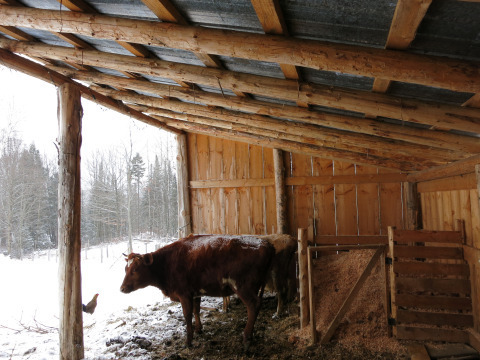It’s the Land That Matters

A fine example of chainsaw hewn post and post construction
When we came to this land, there was no infrastructure. No house, no well, no septic, not even a driveway. The only visible evidence of human habitation was a rusting barbed wire perimeter fence, a 19th-century sugarhouse foundation, and a large pile of garbage; at some point in the property’s relatively recent history, someone had used our new homesite as their private metal and tire dump. Wicked classy.
The lack of infrastructure has proven both blessing and curse. The blessings are that it contributed to the land’s affordability, and that we were able to build our own home. Admittedly, the latter could be seen as a negative, but that was not and is not our view. The curse is that we have spent numerous years establishing infrastructure, investing time, energy, and money that might have been invested in the land itself.
A huge aspect of establishing a thriving small farm involves creating symbiosis between infrastructure, land, crops, and animals, and in this regard, it is perhaps advantageous to begin with raw land. But of course that’s not a possibility for everyone, and the truth is, much of our infrastructure was developed before we had established a sense of how this symbiosis would work for us. Even today, we are constantly evolving the overall “design” of our place to improve functionality, nutrient cycling, human/land/animal interaction, and to reduce our dependence on mechanization. We also think an awful lot about our future on this property. Put bluntly, this is not a place that tolerates physical infirmity, and since we’d like to be kicking around this land well into our 90′s (and really, why stop there?), we are slowing steering things in a direction that will accommodate the slow, hunched shuffle of our aged selves.
We are advocates of simple, inexpensive construction techniques for barns, outbuildings, and even our own shelter. This is not because we wouldn’t necessarily want something grander. Would I like to lay my head under a slate or standing seam metal roof that will outlast my physical being? To be sure. Would I prefer to stack our cows’ annual allotment of hay in a soaring post-and-beam barn, the sunlight flitting through the divided light windows in the cupola? You betcha. But like most people I know, we live with limits of time, skills, and finance, and we have chosen to apply what resources we do have to the restoration of our land and the cultivation and gathering of our food.
I’ve been thinking about this a lot lately, as I’m currently working on my new book for Chelsea Green (this being the one about our land-based practices and processes, not the one for Roost about unschooling/parenting/life in general). There will be a goodly amount of photos in the CG book, and every so often when I remember this, I feel a bit self conscious about the humble nature of our infrastructure. It’s not like our place is hard to look at, and it does have its bucolic charms. “It’s like a homestead empire!” is what my editor said the first time she visited, and I wasn’t the least bit sure how to respond. But empire or no, our home and outbuildings are relatively modest affairs, by-and-large products of our own hands, and as such defined by our limited skill, time, and budget. Our primary barn, which has served us well for nearly a decade and has many more years if not decades of service to go, cost us approximately $2,000, and that was only because we had to buy the roofing and the siding.
I have observed over the years that even the art of homesteading and small-scale farming can become a game of “wants” rather than “needs.” As much as many of us on this path might desire to slip the surly bonds of the first-world consumer economy, we have all been socialized to certain assumptions and expectations, and I find it helpful to remind myself that there are cultures on this Earth that have lived and thrived as tent-dwelling nomads for centuries, living with the land in the most humble and respectful manner imaginable. In other words, we so often need so much less than we talk ourselves into.
I guess I feel compelled to mention all this because I have of late stumbled across a handful for homestead/small-farm reference books (research, ya know) that feature infrastructure far beyond our means and, I suspect, the means of many readers. Again, it’s not as if I wouldn’t want to surround myself with such finely crafted and gorgeous structures, because I would. Who the heck wouldn’t? But over all the years we have passed on this piece of ground, I can honestly say that we have never, not even once been disadvantaged by our rudimentary shelters. Indeed, I suspect that in some ways we have been advantaged by them, if only because they have liberated resources to be applied elsewhere.
For those of you who seek to establish their own small holding (and I know there are at least a few of you reading), remember this: Nice buildings help. They are, well, nice. But it’s the land that matters.

Ben Hewitt's Blog
- Ben Hewitt's profile
- 37 followers



